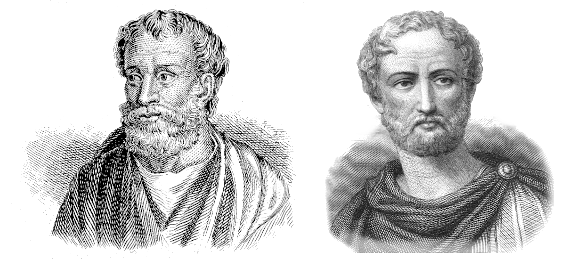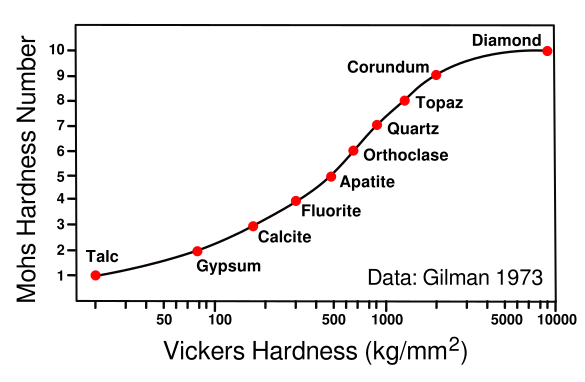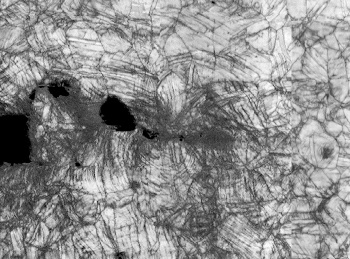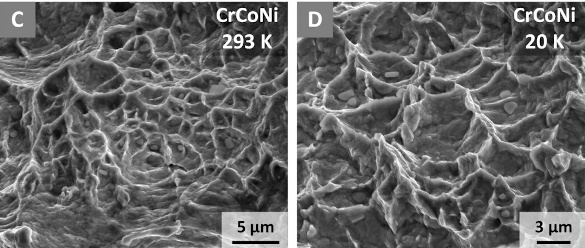Super-Tough CrCoNi Alloy
February 6, 2023
In the
early 20th century, when
graduation from
high school was a terminal
goal in
education, people received much supplementary education from the
cinema. Some
detective movies had a
dramatic scene in which a
gemstone is tested to determine whether it's a genuine
diamond by
scratching a
mirror. However, just as in today's
Internet of
false facts, it's a
misconception that the only
material capable of scratching
glass is diamond itself.
Quartz looks like diamond, and it has a
Mohs hardness of 7, so it will scratch common glass with a Mohs hardness of about 5.5.
Cubic zirconia, which is today's substitute for diamond in inexpensive
jewelry, has a Mohs hardness of about 8.25, and it will easily scratch glass.

Early materials scientists: Theophrastus (c.371 - c.287 BC) (left) and Pliny the Elder (23-79 A.D.), also known as Pliny Secundus (Pliny the Second), on the right. Theophrastus is actually the nickname given to the Greek philosopher by his teacher, Aristotle (384 BC - 322 BC), and it translates to "divine style of expression." His treatise, On Stones, was a useful source for information on gems and minerals into the Renaissance. Theophrastus took a scientific approach by classifying rocks and gems based by their common properties.
Pliny's Naturalis Historia (Natural History, 77 AD) was essentially an encyclopedia of all ancient knowledge available to Pliny, and its importance is underscored by it's being one of the largest single works surviving from the Roman Empire. Pliny died in 79 AD during a rescue attempt of a friend and his family from the famous Mount Vesuvius eruption of that year.
(Left image, line engraving V0005785 from the Wellcome Trust, right image from an 1859 Milanese publication, both slightly modified, from Wikimedia Commons Click for larger image.)
Theophrastus in his
treatise,
On Stones, wrote that harder materials will scratch softer materials, and this fact was mentioned by
Pliny the Elder in his
Naturalis Historia (Natural History, 77 AD).[1-3] The scratch test of
mineral hardness was placed on a
scientific basis in 1812 by
German mineralogist,
Friedrich Mohs (1773-1839). Mohs created what's now called the
Mohs scale of mineral hardness, an
ordinal scale of minerals in which members of higher rank will scratch members of lower rank (see figure).

Relating hardness scales. The Vickers hardness test produces a material hardness number by pressing a pyrimidal indenter into the surface and measuring the dimensions of the indentation.
The graph shown relates Mohs hardness and Vickers hardness for the ten Mohs minerals, Talc, Mg3Si4O10(OH)2; Gypsum, CaSO4·2H2O; Calcite, CaCO3; Fluorite, CaF2; Apatite, Ca5(PO4)3(OH-,Cl-,F-); Orthoclase, KAlSi3O8; Quartz, SiO2; Topaz, Al2SiO4(OH-,F-)2; Corundum, Al2O3; and Diamond, C.
(Data from Gilman,[4] graphed using Inkscape. (Click for larger image.)
Diamond is at the top of Mohs hardness scale, but some materials might be harder than diamond. Diamond derives its
strength from its short, directional
covalent bonds between
carbon atoms, and it's possible that similarly bonded
compounds of low
atomic number elements like
boron, carbon,
nitrogen, and
oxygen will yield high hardness. As I wrote in an
earlier article (Harder than Diamond, August 31, 2012),
beta-carbon nitride (β-C3N4) was
predicted in 1985 to have a hardness like diamond because it also has the same short and particularly
incompressible covalent bonding between
atoms. For that reason it became a target for
synthesis, but there are presently no hardness data available for β-C
3N
4.
The compound,
rhenium diboride (ReB2) can be
synthesized under
ambient pressures, and the
electronegativities of
rhenium (1.9) and boron (2.04) are quite close, so their bonds have a mostly covalent character. A
research team at
UCLA prepared ReB
2 and measured its
microindentation hardness in 2007.[5-6] They found an
average hardness of 48
GPa, whereas diamond has a hardness of more than 140 GPa. However, the UCLA team found that some of their
specimens would scratch diamond, which indicates that ReB
2, an
hexagonal crystal, may be harder than diamond in some of its
crystallographic directions. As an indicator of its incompressibility, the
bulk modulus of ReB
2 was found to be 360 GPa (diamond is 443 GPa).
Materials are an important part of our lives; so, it's no wonder that
authors have created
fictional materials of extreme hardness to embellish their
plots.
Adamantium, sometimes called
adamant or adamantine, is a fictional material of the same hardness as diamond. The
comic book character,
Wolverine, has a
skeleton and
claws strengthened by adamantium. The
gates of hell, as depicted in
John Milton's Paradise Lost and
Virgil's Aeneid, are made of adamant. As Virgil writes,
Respicit Aeneas subito, et sub rupe sinistra moenia lata videt, triplici circumdata muro, quae rapidus flammis ambit torrentibus amnis, Tartareus Phlegethon, torquetque sonantia saxa. Porta adversa ingens, solidoque adamante columnae, vis ut nulla virum, non ipsi exscindere bello caelicolae valeant.[7]
Aeneas straightway by the leftward cliff beheld a spreading rampart, high begirt with triple wall, and circling round it ran a raging river of swift floods of flame, infernal Phlegethon, which whirls along loud-thundering rocks. A mighty gate is there columned in adamant; no human power, nor even the gods, against this gate prevail.[7]
My favorite fictional material is Krell metal, the
construction material of the ancient inhabitants of
Altair IV, the fourth planet of the
star Altair.[8] Krell metal is an important
plot element of the
film,
Forbidden Planet.[8] Altair IV was once populated by the
Krell, an
extinct race that left behind many
artifacts, including many made from Krell metal, a nearly indestructible
alloy much stronger than adamantium.[8]
I wrote about
high-entropy alloys in a
previous article (High-Entropy Alloys, June 20, 2016), These
alloys are created from equal
proportions of elements, so they differ from typical alloys, such as
steel, that have a large
matrix component modified by small additions of other elements. A significant property of high-entropy alloys is their reduced
dislocation mobility that causes dislocations to grow more slowly.
A recent
article in
Science reveals that the high-entropy alloy,
CrCoNi, has outstanding
damage tolerance.[9-12] It's being hailed as the material with the highest
fracture toughness ever measured, and this fracture toughness extends to
cryogenic temperatures.[9-12] High fracture resistance at very low temperatures is unusual, and it's important for
spacecraft exposed to the
cold of
outer space. Research team members are from the
University of Bristol (Bristol, UK),
Lawrence Berkeley National Laboratory (Berkeley, California),
Rutherford Appleton Laboratory (Oxon, UK), the
University of California (Berkeley, California), the
University of New South Wales (Sydney, Australia),
Oak Ridge National Laboratory (Oak Ridge, Tennessee), the
University of Tennessee (Knoxville, Tennessee), and
Ruhr University (Bochum, Germany).[9] The research team was led by
Robert Ritchie of Lawrence Berkeley National Laboratory and
Easo George of Oak Ridge National Laboratory.[11]
The decrease in fracture resistance at low temperatures was the apparent cause of the 1912
sinking of the
Titanic in the
frigid waters of the
North Atlantic.[10] Most alloys show reduced fracture toughness at low temperatures, something that's especially acute at
liquid helium temperature (4.15
K, -269
°C;).[10] The research team investigated both CrCoNi and another low entropy alloy, Cr
MnFeCoNi, at 20 K.[9] CrMnFeCoNi did not perform as well as CrCoNi.[12]

Microscope image of fracture in the CrCoNi alloy during stress testing at 20 kelvin (-424 °F).
The fracture is propagating from left to right.
(Robert Ritchie/Berkeley Lab image, also here. Click for larger image.)
Ritchie and George began
experimenting with CrCoNi and CrMnFeCoNi about a
decade ago, and they found impressive strength and toughness at
liquid nitrogen temperature (77 K).[11] However, the
instrumentation available to them was not capable of testing at temperatures lower than that, and it took a while to assemble a team with the necessary capability.[11] In the end, they were able to use such
analytical tools as
neutron diffraction,
electron backscatter diffraction, and
transmission electron microscopy to characterize such alloys at much lower temperature.[11]
Dislocations are the determinant of both material
ductility and fracture toughness. A greater number of dislocations gives a material more malleabiity, but material irregularities, such a
grain boundaries, can block the dislocations from moving, giving increased strength but also decreased fracture toughness.[11-12] The researchers found that an unexpected
phase transformation from
face-centered cubic to
hexagonal close packed in their high entropy alloys prevented the formation of cracks and their propagation.[9] This mechanism prolonged
strain hardening to increase strength, ductility, and fracture toughness.[9,11] A multi-stage process occurs in which (1) portions of the
crystal lattice slide away from each other such that the
unit cells no longer match up, (2) applied
force produces
nanotwinning, (3) and increased force causes the cubic to hexagonal phase transition.[12]

Electron backscatter diffraction images by a scanning electron microscope showing examples of fractures in CrCoNi at 293 K and 20 K. (Robert Ritchie/Berkeley Lab image, also here. Click for larger image.)
CrCoNi showed a fracture toughness of 459
megapascal-
meters1/2, as high as 500 at 20 k, and CrMnFeCoNi showed 262 megapascal-meters
1/2, and CrCoNi showed a fracture toughness exceeding 540 megapascal-meters
1/2 after 2.25
millimeters of stable cracking.[9-12] In these same units,
silicon is one,
commercial aluminum airframe alloy is about 35, and the best steel is around 100.[11-12] While CrCoNi is
expensive because of the
cost of the component
elements, the research team is investigating alloys formed from less expensive elements.[11] This research was funded by the
U.S. Department of Energy and the
U.K. Engineering and Physical Sciences Research Council, among other agencies.[9]
References:
- Theophrastus, On Stones, Greek Text, English Translation, and Commentary by Earle R. Caley and John F. C. Richards, 1956.
- Pliny the Elder: the Natural History, at Bill Thayer's University of Chicago Web Site.
- Pliny the Elder: the Natural History, Project Gutenberg.
- J. J. Gilman, "Hardness of pure alkali halides," Journal of Applied Physics, vol. 44, no. 3 (March, 1973), pp. 982ff., https://doi.org/10.1063/1.1662382.
- Hsiu-Ying Chung, Michelle B. Weinberger, Jonathan B. Levine, Abby Kavner, Jenn-Ming Yang, Sarah H. Tolbert, and Richard B. Kaner, "Synthesis of Ultra-Incompressible Superhard Rhenium Diboride at Ambient Pressure," Science, vol. 316. no. 5823 (April 20, 2007), pp. 436-439.
- Katharine Sanderson, "Scratching diamond just got easier: Ultra-hard material made in the lab without high pressures," Nature Online, April 19, 2007.
- P. Vergillius Maro, "Aeneid," book VI, ll. 548-554, via the Perseus Digital Library. Latin from J. B. Greenough, "Vergil. Bucolics, Aeneid, and Georgics," Ginn & Co. (Boston, 1900). English translation from Vergil, "Aeneid," Theodore C. Williams. trans., Houghton Mifflin Co. (Boston, 1910).
- Forbidden Planet (1956, Fred M. Wilcox, Director) on the Internet Movie Database.
- Dong Liu, Qin Yu, Saurabh Kabra, Ming Jiang, Paul Forna-Kreutzer, Ruopeng Zhang, Madelyn Payne, Flynn Walsh, Bernd Gludovatz, and Robert O. Ritchie, "Exceptional fracture toughness of CrCoNi-based medium- and high-entropy alloys at 20 kelvin," Science, vol 378, no. 6623 (December 1, 2022), pp. 978-983, DOI: 10.1126/science.abp8070.
- Peng Zhang and Zhe-Feng Zhang, "Getting tougher in the ultracold," Science, vol 378, no. 6623 (December 1, 2022), pp. 947-948, DOI: 10.1126/science.adf2205.
- Aliyah Kovner, "Say Hello to the Toughest Material on Earth," Lawrence Berkeley Laboratory Press Release, December 8, 2022. Also here.
- Michelle Starr, "This Alloy Is The Toughest Known Material on Earth, And It Gets Tougher in The Cold," Science Alert, December 11, 2022.
Linked Keywords: Early 20th century; graduation; secondary education in the United States; high school; goal; education; film; cinema; detective fiction; detective movies; drama; dramatic; scene (filmmaking); gemstone; diamond; abrasion (mechanical); scratching; mirror; Internet; fact-checking; false facts; scientific misconception; material; glass; quartz; Mohs scale of mineral hardness; Mohs hardness; cubic zirconia; jewelry; materials sciencevmaterials scientistvTheophrastus (c.371 - c.287 BC)vPliny the Elder (23-79 A.D.); nickname; ancient Greek philosophy; Greek philosopher; teacher; Aristotle (384 BC - 322 BC); translation; translates; treatise; On Stones; gemstone; gem; mineral; The Renaissance; scientific method; scientific approach; categorization; classify; rock (geology); materials properties; Naturalis Historia (Natural History, 77 AD); encyclopedia; ancient history; Roman Empire; death; died; Eruption of Mount Vesuvius in 79 AD; Wellcome Trust; Wikimedia Commons; science; scientific; Germany; German; mineralogist; Friedrich Mohs (1773-1839); hardness; Vickers hardness test; pyramid (geometry); pyrimidal; indenter; surface; dimension; Cartesian coordinate system; graph; talc, Mg3Si4O10(OH)2; gypsum, CaSO4·2H2O; calcite, CaCO3; fluorite, CaF2; apatite, Ca5(PO4)3(OH-,Cl-,F-); orthoclase, KAlSi3O8<; quartz, SiO2; topaz, Al2SiO4(OH-,F-)2; corundum, Al2O3; diamond, C; Inkscape; ultimate tensile strength; covalent bond; carbon; chemical compound; atomic number; chemical element; boron; nitrogen; oxygen; beta-carbon nitride (β-C3N4); prediction in science; compressibility; incompressible; atom; chemical synthesis; rhenium diboride (ReB2); ambient pressure; electronegativity; rhenium; research; University of California, Los Angeles (UCLA); microindentation; average; pascal (unit); GPa; sample (material); specimen; hexagonal crystal system; hexagonal crystal; crystal structure; crystallographic direction; bulk modulus; authors; fiction; fictional; plot (narrative); adamantium; adamant; American comic book; character (arts); Wolverine (character); skeleton; claw; gates of hell; John Milton; Paradise Lost; Virgil; Aeneid; Aeneas; cliff; rampart (fortification); defensive wall; river; flood; flame; infernal; Phlegethon; gate; column; human; deity; god; construction; Altair IV; star; Altair; plot element; Forbidden Planet; Krell; extinction; extinct; extraterrestrial life; race; artifact (archaeology); alloy; high-entropy alloy; proportionality (mathematics); proportion; steel; matrix; dislocation; scientific literature; article; Science (journal); chromium; Cr; cobalt; Co; nickel; Ni; damage tolerance; fracture toughness; cryogenic temperature; spacecraft; cold; outer space; University of Bristol (Bristol, UK); Lawrence Berkeley National Laboratory (Berkeley, California); Rutherford Appleton Laboratory (Oxon, UK); University of California (Berkeley, California); University of New South Wales (Sydney, Australia); Oak Ridge National Laboratory (Oak Ridge, Tennessee); University of Tennessee (Knoxville, Tennessee); Ruhr University (Bochum, Germany); Robert Ritchie; Easo George; sinking of the Titanic; Titanic; frigid; body of water; waters; North Atlantic; liquid helium; kelvin; K; Celsius; °C;; manganese; Mn; iron; Fe; microscope image; fracture; stress (mechanics); Fahrenheit; °F; Poynting vector; propagate; experiment; experimenting; decade; liquid nitrogen; scientific instrument; instrumentation; analytical tool; neutron diffraction; electron backscatter diffraction; transmission electron microscopy; dislocation; ductility; grain boundary; phase transition; phase transformation; cubic crystal system; face-centered cubic; hexagonal crystal family; hexagonal close packed; work hardening; strain hardening; crystal structure; crystal lattice; unit cell; force; crystal twinning; nanotwinning; scanning electron microscope; pascal (unit); megapascal; meter; millimeter; silicon; commerce; commercial; aluminum; airframe; expensive; cost; shemical element; U.S. Department of Energy; U.K. Engineering and Physical Sciences Research Council.